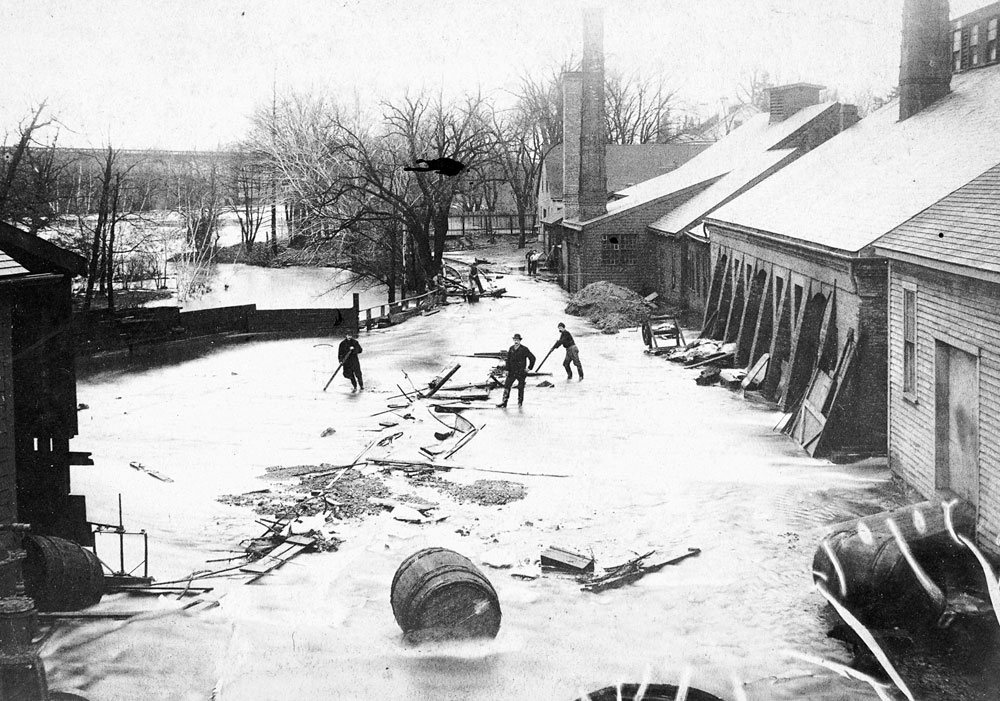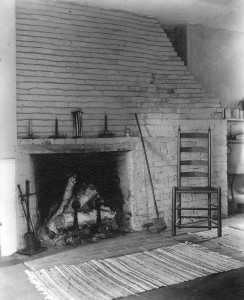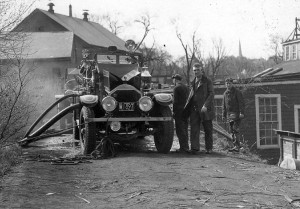True Tales from Canton’s Past: The Case for Rezoning
By George T. Comeau
The Revere Copper Yard after a flood in 1886. Note the Canton Viaduct in the background and the rolling mill on the right. (Courtesy of the Canton Historical Society)
In late December 1800, Paul Revere at age 65 wrote, “I have engaged to build me a Mill for Rolling Copper into sheets which for me is a great undertaking, and will require every farthing which I can rake or scrape. For the Houses which I must necessarily build, I shall want fifteen thousand of Boards & about 25 casks of Lime. If you can supply me with those articles I shall be much obliged to you & wish you to be so kind as to inform me by Post.”
The elderly patriot was building an empire in Canton on the East Branch of the Neponset River. In the old days this site had a small house and mill, which ground corn and a mill that produced boards. Revere transformed the site, almost overnight, with an infusion of $25,000 of his own money and a government loan of $10,000. From that brave start, the site of the Revere Copper and Rolling Mill would employ hundreds of workers and transform a fledgling nation into a naval superpower — all as a result of copper.
Revere flung himself headlong into this new endeavor, took risk and answered every challenge. Not long after he purchased the property, he moved into a modest house that had been built for the town’s miller in 1717. Revere made little improvements to the home, instead spending his money on the factory. For almost 18 years, Revere and his extended family called Canton their home. Successive generations were born here, grew up and went to school here, married at the First Parish Church and are now buried at Canton Corner Cemetery. Today, the remnants of Revere’s time here are few. There is a mural in the Canton Post Office that tells of the birth of the copper industry. Revere’s son’s house is still standing as a private residence on Neponset Street, and there are a few artifacts that are housed at the Canton Historical Society that trace to the earliest residency of Paul Revere. The house itself was demolished in the early 1900s, yet the land on which it stood remains to this day undeveloped.
What we know as Plymouth Rubber is the site where Paul Revere rolled copper for the USS Constitution and the place where bells were cast that grace America’s church steeples. This is the place where cannons were forged that saved the country at war with itself. This is the place where hundreds of men and women worked to supply a nation with products in times of peace. For over 300 years, these banks of the Neponset River have been industrial, and the whispers of the past bring us to a new day.

A rare photograph purportedly of the interior of Paul Revere’s house in Canton (Courtesy of the Canton Historical Society)
Today, we are at a crossroads in the history of the site that built the American copper industry. In a few weeks the voters at a special town meeting will be asked to declare the near future fate of the site known as Plymouth Rubber. Interestingly, if rezoned according to the current plan, nothing that truly connects to Plymouth Rubber will survive in the project. What will survive are major pieces of American history that trace to supplying gunpowder to the Revolution and the subsequent birth of an industry at the hands of one of the most well known patriots of colonial Massachusetts.
The issue of rezoning this polluted industrial site is complex. For those who think maintaining the industrial zoning is the way of the future, I would point out that the property is largely landlocked to major transportation routes. The site historically relied upon rail to reach the vast customers that it served from 1834 through much of the 20th century. Today, however, industry demands rapid access to interstate highways devoid of a downtown Washington Street that largely maintains the same layout it has had for over 200 years. Simply put, the time to rezone this property has come, and the only question is whether the plan devised by the developer, the Planning Board, and the Board of Selectmen is in the best interests of all the major stakeholders.
To this question, this writer believes the answer is a resounding “Yes.” I will not speak to the environmental concerns; there are much more learned individuals that will attest to the plans for cleanup. I will not speak to the density issues; I leave that to my brother Jeremy Comeau and his colleagues on the Planning Board. I cannot speak to the tax implication; that is in the hands of the Finance Committee and Board of Selectmen. What I can speak to are three critical areas of the proposed rezoning: historical preservation, open space, and inclusiveness in the planning process.
Unlike past rezoning attempts, there is no person in this community who can say that this has not been an inclusive, open, and transparent process. The leadership of the entire Board of Selectmen as well as the Planning Board in tandem with Attorney Paul Schneiders and the developer have yielded an open and progressive dialogue into what good development should be on this large site in the heart of Canton. Community meetings, visits to civic groups, open planning sessions, and clear financial implications as well as impacts on traffic and schools has brought us the plan at hand.
For over 10 years, this author has been an ardent advocate for preserving what remains of the original historic mill and barn attributed to Paul Revere’s foundation as carried out by his son Joseph Warren Revere. In 2008 I helped lead the efforts to place the rolling mill and barn on the National Trust for Historic Preservation’s Most Endangered Sites. In that same year, Preservation Massachusetts declared the site as one of Massachusetts’ “Most Endangered Historic Resources.”
And now, more than six years later, we as a town are faced with a great opportunity — a chance to “remediate, restore, and rehabilitate” these nationally significant structures. Also, slightly more than two acres will be given to the town to keep these buildings in context to the historic site. More critically, a plan to use Community Preservation Act funds within a bonding capacity means that “community open space” amounting to more than five acres of land may bring the historic site to a park-like status of almost eight acres in total.
The backstory to this open space plan is complex. It is important to point to local activist and resident Deb Sundin, who chairs the Conservation Commission, for working to create open space within this site, thus reducing the amount of townhouses to be built in close proximity to the historic mill and barn. Just as importantly, Jeremy Comeau has sought to constantly provide balance between the financial needs of the developer and what is best for the town of Canton. For folks who think I am pandering to my brother, anyone who knows us best knows that after my 11 years on the Planning Board, I simply stay out of development issues in broad deference to the current board. Yet many of us know the impact that the CPA has on big and bold ideas. The plan to perhaps “buy” land to serve as open space and eliminate density while protecting historical assets is a critical and worthy topic for the upcoming town meeting.

Canton’s 1925 American LaFrance at one of the frequent fires at Plymouth Rubber. The Revere barn is in the background. (Courtesy of the Canton Historical Society)
So why preserve these long privately held buildings and bring them into public ownership and use? Like Paul Revere in 1801, more than 200 years has passed and now we have the opportunity to preserve a major piece of our legacy and take our place among the nation’s most historic sites. Opening the rolling mill and the Revere barn to the public will enable schoolchildren to understand and contemplate the values of our forefathers. Community pride will swell, and a window into the past will be wiped clean and clear for all to see through.
The plan before us still needs tweaking, and that is what the next several weeks will bear out. From a historical standpoint, assurances must be made that the site where the house that Paul Revere affectionately called “Canton Dale” will be archeologically investigated so we can preserve what is left of the detritus of his 18 years here in Canton. Beneath the soil where the house stood is likely a treasure trove of artifacts that will become part of the story of this site.
In addition, there is a small cut granite revetment wall that dates to the early 19th century. Plans should include avoiding the destruction of this wall that originally served to hold back the north bank of the Neponset River. Over time this wall became critical to the pilings for the railroad spur. It is most likely the oldest remaining feature and an original structure that dates to the time of Paul Revere — and without question needs to be protected. And similarly, there is a stone sluiceway at the truck entrance that dates to between 1834-1835 and is again one of the earliest surviving structures on the property. I call upon our community leaders to solve these last remaining historical issues. The minds that have built this plan are among the best and brightest, and these last three issues can be addressed prior to the special town meeting.
Taken as a whole, the preservation of the barn, the rolling mill, the sluiceway, the revetment wall, and the associated archeology of the Paul Revere house all adds up to an amazing park and historical experience that Canton will be proud of. We are a community that deserves to be recognized for greatness and contributions to the nation.
In the end, I choose to support the zoning change largely because as a local historian I am proud of the accomplishments made by the founders of this town and the men and women who progressively built this place called Canton. This will become a place where we can tell these stories. It is easier to see the benefits of residential versus heavy industry at this site. Coupled with lower density than prior proposals, easements for walking trails, ownership of water rights, and the historical protection for the buildings and artifacts, it will be a vision that matches the entrepreneurial spirit of Paul Revere.
Learn more about the development agreement at town.canton.ma.us/510/2015-annual-town-meeting.
Short URL: https://www.thecantoncitizen.com/?p=28805










